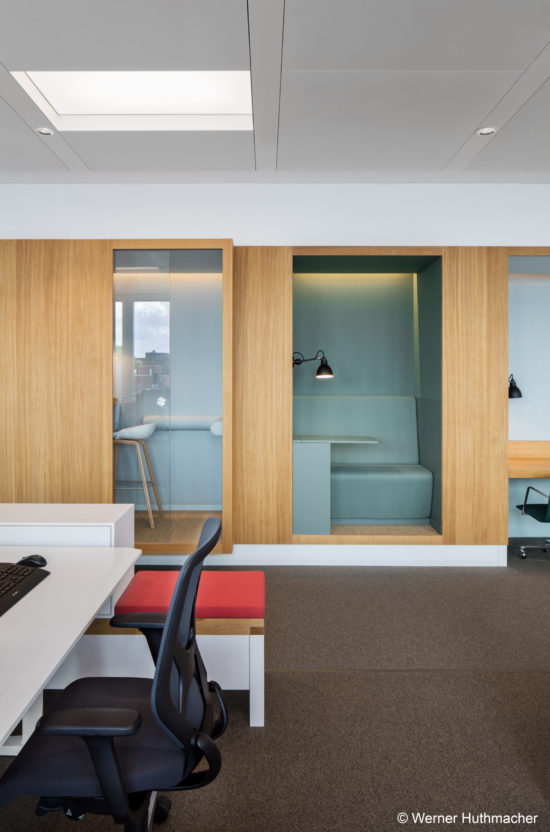
Ulla Basqué is an interior designer who belongs to the bdia (Association of German Interior Architects/Designers) with fire safety certification that includes building category 4 in compliance with art. 62, section 2, sentence 2 no. 1 BayBO (Bavarian Building Ordinance). With Basqué Et Partner, she has been working on projects in offices, stores and apartments for 25 years. As a bdia consultant, she regularly carries out fire safety seminars. Since 2019, she’s been spearheading the Interior design & Design department for shopfitting specialists Aichinger.
Ulla, nowadays, offices have to meet more complex needs than traditional offices in the previous century. As an interior designer, what do you think about this trend?
New remote styles of working are giving rise to digital nomads, people who can work anywhere and at any time. As a result, office concepts are also changing. Many companies have a variety of different project teams, with people drawn from several departments. Consequently, versatile spaces and infrastructure are a must for agile styles of working. A few years ago, the Fraunhofer Institute found out that innovations primarily occur in companies themselves. In many cases, all that’s required is to alternate between focused working and periods of relaxation, e. g. by having an informal chat to other people, in order to come up with new ideas and patterns of behavior. Which is why rooms need to be versatile. Today, offices are open plan with workspaces that can be moved around, as well as lounges or areas to engage in sport. These are break-out spaces where co-workers can get together over a cup of coffee and think outside the box.

What are the changes in terms of interior design planning?
Contemporary offices are flexible and very comfortable with laid-back lounge furniture, open-plan kitchenettes, fabric room dividers and sound-absorbent panels. The open space trend was starting to emerge a few years ago, but the reason was totally different. In order to use space more efficiently, companies are embracing the use of transit or communal areas, or kitchenettes next to printers or photocopiers for meetings. In addition to very good acoustics, this new open-space trend also means that fire safety is vital.

What fire safety challenges are posed in this case?
At the planning stage, we always have to take a nuanced view, which starts with the building category. The categories are based on the type, height and floor space of the building. The higher the building category, the more stringent the requirements. In this case, particular attention is always paid to the transit areas, which the escape and rescue routes are usually also part of. It’s important that no obstacles are placed in the escape routes that decrease their width, which is specified in the fire safety survey. In category 4 and 5 and special-purpose buildings, furniture in the escape and rescue routes even has to be affixed to the floor. Otherwise, if a fire breaks out, people might move the furniture and restrict the width of the escape routes or even block them. Consequently, a nuanced risk analysis can mean that, depending on what the fire safety goal is, a restricted degree of fire loading in rescue routes might be permitted in individual cases.

What role can furniture play in fire safety?
In Germany, upholstery composites are required to meet the DIN 66084 standard. This standard rates and classifies materials based on the results of the DIN EN 1021, part 1, “burning match” testing procedure and part 2, the “glowing cigarette” and DIN 54341 with the “burning newspaper”. Upholstery composites with fire safety characteristics that exceed these have passed the British BS 5852 standard wooden crib test. It’s important to remember that the whole system is tested in each case and not just individual components like the upholstery materials. Items of upholstered furniture with improved fire behavior usually have fire barriers in the form of a non-combustible special fleece between the foam and the upholstery material.
What advice do you give planners about selecting furniture?
Even if calls for tender specify the rating of building materials and not furniture, it’s always a good idea to look at the information provided by the manufacturer. What are the frame, cover and upholstery made of? Do the materials already meet the factory requirements? Furniture can make an important contribution to fire safety if the upholstered furniture self-extinguishes. This is not required by any standards, but if a fire does break out, it’s a good way of saving lives in very busy and open-space interiors.
Thank you very much for speaking with us!
